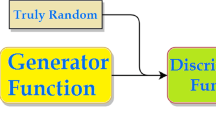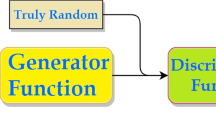Abstract
In this paper, a GAN-based optimal neural network structure for group synchronization is proposed. For generating a key between two parties, asymmetric cryptography is commonly used to exchange the key over an unprotected medium. However, as the approaches that used this technique, such as RSA, have been compromised, new ways to produce a key that can provide protection must be found. To address this problem, a new branch of cryptography known as neural cryptography was developed. The main goal of this neural cryptography is to generate a secret key using an insecure medium. This paper gives an analysis of the ideal neural network configuration for generating and establishing a secret key between the two authenticated entities. Also, research into the synchronization of a group of neural networks is rare. For the design of the public key exchange protocol, a Generative Adversarial Network (GAN)-based synchronization of a group of neural networks with three hidden layers is proposed. For neural synchronization, GAN is used for Pseudo-Random Number Generators (PRNG). More than 15 million simulations were performed to determine the coordination time, steps were taken, and the number of times the attacking neural network could reproduce the behavior of the two approved networks. Various parametric experiments have been conducted on the proposed methodology. In terms of the paper’s cited findings, simulations of the method indicate that it is accurate.

















Similar content being viewed by others
References
Abadi M, Andersen DG (2016) Learning to protect communications with adversarial neural cryptography. arXiv:1610.06918
Abdalrdha ZK, AL-Qinani IH, Abbas FN (2019) Subject Review : Key Generation in Different Cryptography Algorithm. International Journal of Scientific Research in Science, Engineering and Technology 6(5):230–240. https://doi.org/10.32628/ijsrset196550
Allam AM, Abbas HM, El-Kharashi MW (2013) Authenticated key exchange protocol using neural cryptography with secret boundaries. In: Proceedings of the 2013 International Joint Conference on Neural Networks, IJCNN 2013, pp 1–8
Bauer FL (2011) Alberti Encryption. In: van Tilborg HCA, Jajodia S (eds) Encyclopedia of Cryptography and Security. Springer, Boston, MA, DOI https://doi.org/10.1007/978-1-4419-5906-5_159, (to appear in print)
Chourasia S, Bharadwaj HC, Das Q, Agarwal K, Lavanya K (2019), vol 8
Desai V, Deshmukh VB, Rao DH (2011) Pseudo random number generator using Elman neural network. IEEE Recent Advances in Intelligent Computational Systems, pp 251–254
Dolecki M, Kozera R (2015) The Impact of the TPM Weights Distribution on Network Synchronization Time. In: ComputerInformation Systems and Industrial Management, vol 9339. Springer International Publishing, pp 451–460
Dong T, Huang T (2020) Neural Cryptography Based on Complex-Valued Neural Network. IEEE Transactions on Neural Networks and Learning Systems 31(11):4999–5004. https://doi.org/10.1109/TNNLS.2019.2955165
Édgar Salguero Dorokhin, Fuertes W, Lascano E (2019) On the Development of an Optimal Structure of Tree Parity Machine for the Establishment of a Cryptographic Key. Security and Communication Networks 2019:1–10. https://doi.org/10.1155/2019/8214681
Gao J, Yang X, Jiang Y, Song H, Choo K K R, Sun J (2021) Semantic Learning Based Cross-Platform Binary Vulnerability Search For IoT Devices. IEEE Transactions on Industrial Informatics 17(2):971–979. https://doi.org/10.1109/TII.2019.2947432
Goodfellow IJ, Pouget-Abadie J, Mirza M, Xu B, Warde-Farley D, Ozair S, Courville A, Bengio Y (2014) Generative Adversarial Nets. Proceedings of the 27th International Conference on Neural Information Processing Systems, Montreal, Canada, vol 2, pp 2672–2680
Hadke PP, Kale SG (2016) Use of neural networks in cryptography: a review. In: Proceedings of the 2016 World Conference on Futuristic Trends in Research and Innovation for Social Welfare (Startup Conclave), pp 1–4
Jeong S, Park C, Hong D, Seo C, Jho N (2021) Neural Cryptography Based on Generalized Tree Parity Machine for Real-Life Systems. Security and Communication Networks 2021. https://doi.org/10.1155/2021/6680782
Jeong Y, Oh K, Cho C, Choi H (2018) Pseudo Random Number Generation Using LSTMs and Irrational Numbers. 2018 IEEE International Conference on Big Data and Smart Computing (BigComp), pp 541–544
Kanso A, Smaoui N (2009) Logistic chaotic maps for binary numbers generations. Chaos, Solitons & Fractals 40(5):2557–2568. https://doi.org/10.1016/j.chaos.2007.10.049
Kanter I, Kinzel W, Kanter E (2002) Secure exchange of information by synchronization of neural networks. Europhysics Letters (EPL) 57 (1):141–147. https://doi.org/10.1209/epl/i2002-00552-9
Kanter I, Kinzel W, Kanter E (2002) Secure exchange of information by synchronization of neural networks. Europhysics Letters (EPL) 57 (1):141–147. https://doi.org/10.1209/epl/i2002-00552-9
Karakaya B, Gülten A, Frasca M (2019) A true random bit generator based on a memristive chaotic circuit: Analysis, design and FPGA implementation. Chaos Solitons Fractals 119:143–149
Kelsey J, Schneier B, Wagner D, Hall C (1998) Cryptanalytic Attacks on Pseudorandom Number Generators. In: S V (ed) Fast Software Encryption. FSE, vol 1372. Springer
Klimov A, Mityagin A, Shamir A (2002) Analysis of neural cryptography. In: Proceedings of the 8th International Con- ference on the Reory and Application of Cryptology and In- formation Security, pp 288–298
Lindell Y, Katz J (2014) Introduction to modern cryptography. Chapman and Hall/CRC, London
Liu L, Miao S, Hu H, Deng Y (2016) Pseudo-random bit generator based on non-stationary logistic maps. IET Inf. Secur. 2 10:87–94
Liu P, Zeng Z, Wang J (2019) Global synchronization of coupled fractional-order recurrent neural networks. IEEE Trans. Neural Netw. Learn. Syst 30 (8):2358–2368
Lu Y, Huang X, Dai Y, Maharjan S, Zhang Y (2020) Blockchain and Federated Learning for Privacy-Preserved Data Sharing in Industrial IoT. IEEE Transactions on Industrial Informatics 16(6):4177–4186
Makkar A, Garg S, Kumar N, Hossain MS, Ghoneim A, Alrashoud M (2021) An Efficient Spam Detection Technique for IoT Devices Using Machine Learning. IEEE Transactions on Industrial Informatics 17(2):903–912. https://doi.org/10.1109/TII.2020.2968927
Mehic M, Niemiec H, Siljak M, Voznak (2020) Error reconciliation in quantum key distribution protocols. In: Proceedings of the International Conference on Reversible Computation, pp 222–236
Niemiec (2019) Error correction in quantum cryptography based on artificial neural networks. Quantum Information Processing 18:174–174
Niemiec M, Mehic M, Voznak (2018) Security verification of artificial neural networks used to error correction in quantum cryptography. In: Proceedings of the 26th Tele- communications Forum (TELFOR), pp 1–4
NIST (2020) NIST Statistical Test. http://csrc.nist.gov/groups/ST/toolkit/rng/stats_tests.html
Pal SK, Mishra S, Mishra S (2019) An TPM based approach for generation of secret key. International Journal of Computer Network and Information Security 11(10):45–50
Patidar V, Sud KK, Pareek NK (2009) A pseudo random bit generator based on chaotic logistic map and its statistical testing. Informatica 33:441–452
Protic D (2016) Neural cryptography. Vojnotehnicki glasnik 64 (2):483–495. https://doi.org/10.5937/vojtehg64-8877
Rukhin A, Soto J, Nechvatal J, Smid M, Barker E (2001) A statistical test suite for random and pseudorandom number generators for cryptographic applications
Ruttor A, Kinzel W, Kanter I (2007) Dynamics of neural cryptography. Physical Review E 75(5). https://doi.org/10.1103/physreve.75.056104
Ruttor A, Kinzel W, Naeh R, Kanter I (2006) Genetic attack on neural cryptography. Physical Review E 73(3). https://doi.org/10.1103/physreve.73.036121
Santhanalakshmi S, Sangeeta K, Patra GK (2015) Analysis of neural synchroniz ation using genetic approach for secure key generation. Communications in Computer and information science 536:207–216
Santhanalakshmi S, Sudarshan T, Patra GK (2014) Neural synchronization by mutual learning using genetic approach for secure key generation. In: Proceedings of the International Conference on Security in Computer Networks and Distributed Systems, pp 422–431
Sarkar A (2019) Multilayer neural network synchronized secured session key based encryption in wireless communication. International Journal of Artificial Intelligence 8(1):44–53
Sarkar A, Mandal JK (2012) Swarm Intelligence based Faster Public-Key Cryptography in Wireless Communication (SIFPKC). International Journal of Computer Science & Engineering Technology (IJCSET) 3(7):267–273
Shacham LN, Klein E, Mislovaty R, Kanter I, Kinzel W (2004) Cooperating attackers in neural cryptography. Physical Review E 69(6). https://doi.org/10.1103/physreve.69.066137
Shishniashvili E, Mamisashvili L, Mirtskhulava L (2020) Enhancing IoT Security Using Multi-Layer Feedforward Neural Network with Tree Parity Machine Elements. International Journal of Simulation Systems Science & Technology 21(2):371–383. https://doi.org/10.5013/ijssst.a.21.02.37
Srinivas J, Das AK, Li X, Khan MK, Jo M (2020) Designing anonymous signature-based authenticated key exchange scheme for internet of things-enabled smart grid systems. IEEE Trans Indust Info 17:4425–4436
Tirdad K, Sadeghian A (2010) Hopfield neural networks as pseudo random number generators. Annual Meeting of the North American Fuzzy Information Processing Society, pp 1–6, https://doi.org/10.1109/NAFIPS.2010.5548182
Acknowledgments
The author expressed deep gratitude for the moral and congenial atmosphere support provided by Ramakrishna Mission Vidyamandira, Belur Math, India.
Funding
This research did not receive any specific grant from funding agencies in the public, commercial, or not-for-profit sectors.his research received no external fundings.
Author information
Authors and Affiliations
Corresponding author
Additional information
Conflicts of Interest
No conflict of Interest.
Publisher’s note
Springer Nature remains neutral with regard to jurisdictional claims in published maps and institutional affiliations.
Rights and permissions
About this article
Cite this article
Sarkar, A. Development of GAN-based optimal neural network structure for group synchronization. Multimed Tools Appl 81, 28999–29025 (2022). https://doi.org/10.1007/s11042-022-12601-z
Received:
Revised:
Accepted:
Published:
Issue Date:
DOI: https://doi.org/10.1007/s11042-022-12601-z




